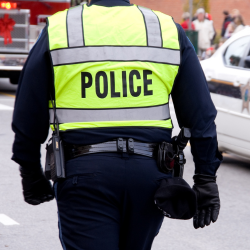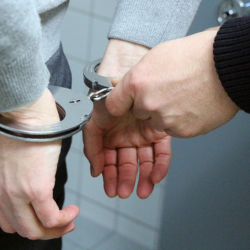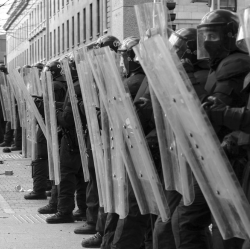Tip #1: Officer Mental Health
For this year’s National Police Week, the Comp Alliance will again start with the vital importance of police officers’ mental health and wellness. Traditional occupational safety and health risk management programs primarily concentrate on ensuring that work is safe, and workers are protected from workplace hazards that arise from the work itself. This includes dealing with hazardous chemicals, improved housekeeping, and PPE procedures. Police officers need to understand these physical controls. Additionally, officers deserve mental health protection from the hazards of stress, fatigue, burnout, and substance abuse. Employees who endure work-related struggles that negatively impact their well-being are at a substantially higher risk of poor health and injury.
The Law Enforcement Mental Health and Wellness Act of 2017 (LEMHWA) was signed into law in January 2018, providing support for law enforcement agencies’ ongoing efforts to protect their employees' mental health and well-being. Good mental health is just as essential as good physical health for law enforcement officers to be effective in keeping our communities safe from crime and violence[1].
To promote police officer mental health, consider these resources and share applicable information with your department staff at all levels:
- Municipal Employee Assistance Programs: These programs are important and should be promoted by police agencies. Every officer is different and not everyone will come to their police agency if they are unable to sleep or if stress is harming their lives. Multiple options should be made available to police officers through their agency. Consider peer support groups or officer-led programs where discussions on trauma-related stress can be held in confidence with trusted coworkers taking the lead.
- Supervisor Training: Field Training Officers (FTO) who recognize adverse stress reactions and signs of chronic stress can identify trauma or stress-related challenges in their subordinates. Administrators can follow up to provide troubled officers with resources and support including a change in shift assignment, time off to resolve an acute stressor, sleep concerns, or more formal support such as professional counseling.
- Stress-Related Meetings: Positive police management includes routine discussions with police staff on the importance of mental health improvements. Talking about stress management during employee reviews, meetings, and briefings provides an opportunity for the trained supervisor to encourage an honest discussion of any problems officers may be experiencing. Such a discussion opens the door for an officer who is struggling to reach out for support. It also provides an opportunity for supervisors to identify a potential problem before any adverse stress reactions could affect the officer’s safety.
- Create Motivation Programs: Develop ideas where officers are encouraged and motivated to attend stress-reducing programs that build comradery including yoga, exercise events, and sporting activities. Include family and spousal support organizations where officer families and spouses can come together to provide insight into common stressors and experiences. After an officer experiences a traumatic event, offering counseling for spouses might also be effective. When police families cope well with stress, it is more likely that the officers will remain focused while on duty.
This week we honor the vital work of our police departments. The Comp Alliance recognizes the incredibly important and difficult jobs that you all have. We appreciate all you do and hope these short safety bulletins will be a reminder of our appreciation and help to improve the safety of the department.
[1] U.S. Department of Justice - https://cops.usdoj.gov/lemhwaresources
Resources on Mental Health:
NYS Alliance on Mental Illness: https://www.naminys.org/nys/mental-health-awareness-month/
U.S. Department of Justice:https://bja.ojp.gov/program/pmhc
International Association of Chiefs of Police: https://www.theiacp.org/topics/mental-health
May is National Mental Health Month: https://mhanational.org/mental-health-month
Tip #2: PPE
The Comp Alliance works with a variety of departments, each with unique risks and hazards to control. One shared means of protection for all employees is the use of personal protective equipment (PPE). Police departments are not without the need for proper PPE, whose safe use can prevent injuries while on patrol, during a chase, and back at the police station.
Police PPE is much more than donning a ballistic vest, and should include the following:
- Footwear: A well-fitting work boot with anti-slip soles can provide comfort and safety for officers often on their feet. Appropriate footwear can aid in foot pursuits and managing environments with broken glass, like auto accidents, and
 other debris.
other debris. - Disposable Gloves: To prevent the contraction of a bloodborne pathogen or drug exposure, like fentanyl, the barrier that gloves provide can be vital. Disposable nitrile or latex gloves used by police officers should fit comfortably and be durable. Training on Bloodborne Pathogens, including the use of disposable gloves, is required annually for officers.
- Tactical Gloves: Police gloves are generally designed for multiple uses including puncture resistance, shooting assistance, evidence collection, and grip improvement. Darker shades help to identify light-colored evidence and blend in with tactical gear.
- Reflective Gear: Police officers can be injured due to limited visibility from oncoming traffic while dealing with routine traffic issues. Reflective clothing should be worn for these situations. Follow current ANSI 107 standards for the appropriate reflective rates. Clothing reflections should cover the body 360 degrees and be rated at high visibility Level 3, including high-speed traffic and night-time reflectivity.
- Hearing and Eye Protection: While not worn on a routine basis, hearing and eye protection can help protect officers from loud noises, flying debris, or sunlight. Hearing protection can be difficult to utilize as some systems limit an officer’s situational awareness, so investigate active systems that allow for outside awareness. Officers working daytime shifts could benefit from sunglasses with UV 400 ratings for protection from the sun’s rays. Safety glasses should be worn where flying debris may be encountered to provide additional protection.
- Clothing: Ballistic vests are commonplace, and departments develop policies on their use and care. Follow manufacturer instructions for care and keep your vest dry before use. Wear a soft, comfortable shirt under the vest, and roll out new vests to improve comfort. Outerwear should be comfortable and provide clear identification. Any nighttime wear should have proper reflectivity.
As with any high-hazard job position, the proper use of personal protective equipment goes a long way to protect against recognized hazards. PPE must be approved by administration and be readily available for staff. At no time should PPE use be restricted for staff members. Remember, PPE only works if you wear it!
Tip #3: De-Escalation
One common topic of discussion is police-public interaction during confrontations in the field. This can include scenarios like arrests, crowd control, and investigations. With increased scrutiny from the public, improving techniques to handle these situations can positively benefit a department’s reputation and police officer safety.
De-escalation is defined as a method to prevent potential violence; using an approach aimed at reducing intensity to resolve conflicts. It involves purposeful actions, verbal communication, and body language to stabilize, slow or reduce the intensity of a potentially violent situation without using physical force or reducing necessary force.[1] De-escalation training is well known and has been introduced into officer schooling at the police academy. It should be common knowledge for any academy graduate and especially seasoned officers. Everyone can benefit from improved de-escalation knowledge.
intensity of a potentially violent situation without using physical force or reducing necessary force.[1] De-escalation training is well known and has been introduced into officer schooling at the police academy. It should be common knowledge for any academy graduate and especially seasoned officers. Everyone can benefit from improved de-escalation knowledge.
The appropriate use of de-escalation techniques can go a long way in keeping officers and their colleagues safe. Beginning encounters with de-escalation tactics benefit both officers and citizens. Officers should work to de-escalate before a situation spirals into adverse or demanding conditions. Proper training and the use of de-escalation techniques can calm hostilities before they become violent or make potentially violent conditions manageable. These techniques are vitally important to a police officer’s protection in the field and are another means of officer protection.
An officer should have an understanding of the following:
- De-escalation is a method to prevent potential violence.
- Your safety and the safety of others around you is the highest priority.
- Know your limits and where the confrontation is going.
- Obtain help from other officers and move to a safe location.
As part of a de-escalation training program for your department, purposeful actions include:
- Slow down and observe the initial situation. Take a second to evaluate the conditions and the environment around you and hold off on an immediate intervention.
- Remain calm and composed and maintain a safe distance to respect personal space.
- Use verbal communication. Be compassionate but firm in defusing a tense situation. Speak calmly but directly, avoid raising your voice, and slow down your speech to be understood.
- Maintain positive body language. Keep relaxed but alert, slow down your actions, use deliberate movements, and maintain a neutral and attentive facial expression.
Not all situations can be de-escalated. Active shooter situations require law enforcement to actively seek and neutralize the threat. While it is preferred that an officer attempt de-escalation when warranted, sometimes a suspect’s actions require harsher responses and interactions.
Police officers who effectively use de-escalation in the field have been found to have reduced stress, as encounters are often resolved without physical interactions. When public interactions are successfully resolved without conflict, the department’s reputation is improved throughout the community. Update policies, practices, and training on de-escalation techniques to improve officer safety and reduce workplace injuries.
[1] U.S. Department of Homeland Security
Tip #4: Crowd Control
Police officers can get into a variety of dangerous situations performing police operations including traffic stops, domestic disputes, brawls, and chases. Oftentimes crowd control occurs alongside many of these circumstances. Crowd control is also necessary for sporting events, controversial court verdicts, and parades. For example, should a routine traffic stop turn violent, people may gather to witness the event and record it. In this instance, police must deal with not only the offending party but also bystanders who may try to intervene. There are many forms of crowd control and using the proper procedures benefits your officers.
Crowd control procedures focus on the task of controlling large or gathering groups with a limited number of police officers. Use policies, planning, and tactics equally to mitigate damage and injuries sustained should a crowd become riotous or beyond the control of the officers present. Crowd control procedures should cover planned and unplanned events, from a holiday parade to a riot. Police presence at these events requires officers to have situational awareness of any growing concern.
 At demonstrations, political rallies, and protests, hostilities can escalate quickly. A solid police presence can be the difference between control and total mayhem. Special equipment such as helmets, batons, shields, and less-than-lethal weapons should be available for use during such events. All staff intending to use the conflict engagement PPE should attend relevant training. Some crowd control tactics your police agency should have in place to maintain order:
At demonstrations, political rallies, and protests, hostilities can escalate quickly. A solid police presence can be the difference between control and total mayhem. Special equipment such as helmets, batons, shields, and less-than-lethal weapons should be available for use during such events. All staff intending to use the conflict engagement PPE should attend relevant training. Some crowd control tactics your police agency should have in place to maintain order:
Plan and Set-Up: Routine events expecting crowds still require planning for traffic control, officer locations, officer responsibilities, and anticipated outcomes. While sudden events do not allow for pre-planning, a policy on such events allows departments to respond and handle them smoothly. Single-officer crowd events, like traffic violations that escalate, may require the removal of the officer until assistance is provided. Plan for these situations as well.
Communication, Equipment, and Skills: Communication should be prioritized to reinforce that officers are in charge. Communicating status updates as events change rapidly during large gatherings, moving units around the site, denoting changes in the environment, and denoting when an event has concluded helps maintain order. Additionally, positive communication like officer de-escalation can alleviate conflict.
Crowd Control Team Tactics: When police departments are trained in team tactics, fewer officers can accomplish more. Officers trained to form, fall into, extend, and move within a line, column, or wedge formation while in stressful environments can be extremely effective in deterring unruly groups.
Team Arrest Skills: Train on making a team physical arrest quickly and efficiently in the presence of a crowd, particularly one that is growing in size and hostility. Ensure that professionalism is a top priority.
Crowd Dynamics: Officers must recognize the dynamics that exist in every crowd. For example, many good people, who are followers, will engage in a violent disturbance if malevolent leaders are not deterred or arrested. Voice commands with a show of force are likely to turn back good bystanders from engaging further.
Personal Protective Equipment: More hostile encounters are likely to require specialty officer divisions using specialty equipment. Have enough equipment ready for the number of officers planned for the event.
Additional Food for Thought: Plain clothes observers, cameras, body cameras, detours and alternate routes, mutual aid availability, mobility of forces, and less-than-lethal munitions all play a role in your ability to successfully control gathering crowds.
Crowd control requires planning, training, knowledge of your community, and specialty equipment. From the routine parade to the unforeseen response to a community event, police departments that prepare beforehand are more likely to be successful in keeping events calm, peaceful, and lawful.
Tip #5: Less-Than-Lethal Force
In recognition of National Police Week 2023, the Comp Alliance developed safety tips aimed at providing information to protect officers from workplace injuries. The final tip of the week is a discussion on the use of less-than-lethal force, a strategy that can provide improved safety for officers when interacting with the public.
Less-than-lethal force, or less lethal force, is any use of force that is not considered deadly and involves physical effort to control, restrain, or overcome the resistance of another. This encompasses manual restraint, electronic control weapons, aerosol sprays, and impact projectors. These weapons provide an alternative force option that is less likely to result in a fatality while still effectively subduing a person with little to no harm to the police officer.
Studies have shown that when officers use less lethal technology, they are likely to suffer fewer and less severe injuries. Additionally, deadly force is not necessary in most instances so the impact on officers’ mental health is likely to be greatly reduced. Officers have often stated that using a Taser or pepper spray saved them from performing a riskier solution during an escalating situation.
greatly reduced. Officers have often stated that using a Taser or pepper spray saved them from performing a riskier solution during an escalating situation.
There are several types of less lethal force devices including:
- Electronic Control Devices (ECDs) like Tasers and stun guns.
- Remote restraint devices like a BolaWrap.
- Chemicals, for example, pepper spray and tear gas.
- Vehicle-stopping technology equipment that stops cars during a pursuit, like spike strips.
- Barriers such as nets, foams, and other physical barriers.
- Blunt force items, namely regular or collapsible batons, and projectiles.
Staff training is an absolute must when your department seeks to utilize one or more of these devices. Training must be completed upon initial introduction to the department, when an officer displays incompetence with the device, or when an officer changes job functions. Document all such training and conduct routine refreshers as recommended. The goal of training is to confirm that the administration has the utmost confidence in the officers’ understanding of the safe use of such devices and their ability to follow policy on their utilization.
We hope that these week-long safety tips during National Police Week were a help to your department and municipality. The Comp Alliance is here to assist our members and their employees in reducing and preventing workplace injuries. Please reach out to the Director of Loss Control, Robert Blaisdell, at This email address is being protected from spambots. You need JavaScript enabled to view it. or (518) 330-8591 for more information on this topic or any of the topics discussed during the week. We wish our police departments the very best in providing safety and security for their communities and police officers.

